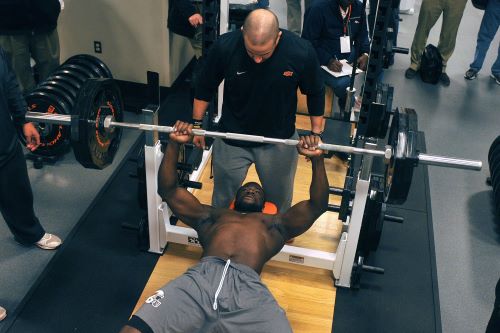
"March 13, 2021 David Sautter NASM CPT, FNS, PES; ACE SCS
(Last Updated On: September 24, 2023)
Power relates to the amount of force you can produce as quickly as possible. Let’s take a sprint as an example.
Unlike a casual stroll or jog, a sprint requires all your effort at the same time. You are literally trying to move as fast as you physically can.
Jumping is another great example. Whether you’re trying to provide defense for your team or hit that winning shot over the net, a jump focuses all of your power into one action.
Finally, if you’re trying to throw a fastball, you are generating raw power in order to launch the ball across the plate.

Training for Power
When an athlete trains for power, the primary goal is to increase how much force is produced. Again, force relates to the physical energy your body produces.
Athletes can increase the amount of force they produce during training in three important ways:
- Activate the greatest number of muscle groups and fibers.
- Increase the synchronicity between the muscle groups and fibers.
- Safely increase the speed at which the muscle groups are triggered.
In other words, training for power involves primarily total body movements that allow you to safely generate force at a high rate of speed.
An example of an ideal power training exercise would be the deadlift, which involves multiple muscle groups during a fast-paced hip-hinge-focused movement.
Related: Build Explosive Athletes Using the Dynamic Effort Method

Power vs. Strength: Is There a Difference?
While strength training and power training involve applying maximal force against a load such as bodyweight or a barbell, the difference between them is the speed of the movement.
Strength training tends to focus more on heavier loads at a controlled moderate speed. Power training, on the other hand, uses lighter loads at high speeds.
An example would be the traditional bench press vs. wall ball throws and slams.
During a bench press, the athlete performs the exercise with a weight load that is 65% to 85% of their one-repetition maximum. The exercise is usually performed quickly during the concentric (lifting) phase and slowly during the eccentric (lowering) phase.
The tempo of 1-0-3 is often used. Each number corresponds to the seconds spent in the contraction, isometric, and eccentric phases, respectively.
A wall ball slam, on the other hand, will use a lighter weight, usually around 30% to 45% of the athlete’s one-repetition maximum. But the tempo will be significantly increased, requiring the athlete to perform the prescribed repetitions as fast as they can.

Related: 10 Exercises to Build Power in Athletes
Power Training vs. Strength Training: Which One is Better?
It turns out that you need both types of workouts to complement a well-rounded athletic training program.
Multiple studies have demonstrated the benefit of combining several types of strength and power-focused training.
One method of doing this is by pairing plyometric exercises with traditional strength training exercises. For example, you perform a set of barbell squats (strength) and immediately go into a set of jump squats (power).
Benefits of Athletic Power
Let’s take a closer look at the benefits of athletic power training and how it can help average gym goers as much as seasoned athletes.
Athletic Performance: Studies show that power training produces greater gains in athletic performance, especially jump height, running speed, and force production. It should be noted that if you are combining strength and power training, you’ll want to perform the strength exercise first as power movements can quickly zap energy. [1]
Weightlifting: Research suggests that the increase in raw force production during power training complements traditional weightlifting workouts. Individuals often see an increase in the amount of weight used during strength training as well as efficiency of control and muscular endurance. [1]
Lean Mass: Since power training focuses on high rates of speed, it is effective for activating your fast-twitch muscle fibers. Also referred to as Type II muscle fibers, these fibers are the focus of muscle-building workouts because they are more superficial or near the surface. [2]
Fat Loss: Both strength and power training have been shown to increase caloric expenditure and promote long-term fat loss. [3]
Ideal for Older Adults: Age-related muscle and bone loss is normal. The key is not to let yourself become sedentary. An active lifestyle has been shown to decrease and prevent sarcopenia (muscle loss) and osteoporosis (bone loss). Athletic power training utilizes exercises that activate fast-twitch muscle fibers, which is ideal for muscle growth. What’s more, many plyometric exercises are high impact, promoting greater bone density. [4]
Decreased Risk of Injury: Studies suggest that proper power and strength training can decrease the risk of injury from day-to-day movements and future workouts. The focus on proper movement and posture translates well into real-world activities and errands. [5]

How to Increase Power (Based on Science)
If you want to increase athletic power, studies suggest that the best way to do it is by alternating the following training styles:
First, train with heavy loads that are 85% to 100% intensity or choose a weight that you can safely and properly pick up between one to five repetition maximum. As we’ve discussed above, move as quickly as you can with perfect form and execution.
Second, train with light loads that are 30% to 45% one-repetition maximum intensity or choose a weight that you can safely lift for 8 to 10 repetitions at high speeds.
Focus on heavier training loads first then complement the rest of the workout with the lighter training loads and faster speeds.[...]"

(For the rest of David Sautter's article on Power Building Workouts To Build Explosive Athletes click on The Athletic Build link above)
David Sautter NASM CPT, FNS, PES; ACE SCS
David J. Sautter has combined a lifelong passion for writing with over a decade of experience as an NASM-certified personal trainer, fitness-nutrition specialist, and sports-conditioning specialist. David has written hundreds of blog posts as well as dozens of e-books, training guides, and online courses covering a range of health and fitness topics. In his free time, David enjoys writing about staying fit while traveling abroad for his blog, FitnessWanders.com. Learn more about David Sautter at WriteFit.com.


